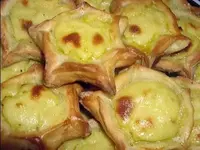Komi kitchen

To begin with, we invite you to make a small excursion into the history of the Komi Republic and its indigenous inhabitants of the Zyryans. Komi or the Komi Republic is located in the northern latitudes.
Winter here is long and long, and summer is fleeting, but warm. The indigenous population of the Komi Republic includes 4 main nationalities - Komi-Zyryan, Komi-Permian, Komi-Izvintsy and Komi-Inzhemtsy.
Climatic conditions dictate their own rules, so zyryans have been making blanks for the winter since ancient times. The history of the modern state of Komi began in the early 19th century, namely in 1921, when the USSR leadership assigned the territory the status of an autonomous region.
In ancient times, it was on the territory of the modern Komi Republic that skillful hunters mined the fur of the beast and sent it by convoys to the capital city of Moscow. Interestingly, almost until the 18th century, only the indigenous population of this land lived in the territory of Komi.
The northern nationalities adapted to life in such harsh climatic conditions and famously coped with all the difficulties. And the lack of roads in winter made communication between Komi and the outside world much more difficult.
The development and development of the new territory of the Komi Republic began with a notorious fact in the modern history of the Russian Federation. The most famous and cruel Stalinist camp GULAK and its units were located on the territory of the Komi Republic. Thousands of prisoners arrived in the Gulag every day, with whose forces and all infrastructure facilities were built on the territory of Komi, roads, industrial factories, factories, and railway tracks were laid. From that moment on, the Komi Republic began to develop rapidly, the increase in the population due to the "visitors" made some adjustments to the centuries-old foundations of the Zyryans.
A distinctive feature of the national recipes of Komi cuisine is that they were greatly influenced by the traditions of residents of neighboring territories. Many Komi dishes were borrowed from residents of the Tyumen region, Perm Territory, Arkhangelsk, as well as from Khanty-Mansians and residents of the Yamalo-Nenets Autonomous Okrug.
In the Komi Republic, all the main nationalities have their own Komi cuisine and traditions of their preparation. But there are also nationwide recipes for Komi cuisine, such as the famous Shangi treat. This is a baking in the form of a circle or sun, because the name of this dish is derived from the word shondi (translated as sun).
The basis of the diet of all Komi nationalities was porridge and baking. They could cook porridge on an open fire or in a pot in a stove. To provide the body with vitamins and useful substances, residents of Komi always added berries, nuts or mushrooms to porridge. Obviously, the diet of residents of the northern regions of the Komi Republic was significantly different from those dishes that were prepared in the south of the republic.
After all, what products can a person get, collect or grow, then he consumes it later. The Komi-Izhem people have always been considered noble hunters, so their diet is replete with venison and stroganina. But Yazhemtsy do not go to berries-mushrooms and do not cook beer, because it is not possible to grow cereals in their climatic zone.
It is unique that as such, drinking and alcohol traditions simply do not exist among all Komi nationalities. There are drinks containing alcohol, but they were usually consumed rarely, mainly for ritual actions (Sur drink). On holidays, residents of Komi consumed wort (the basis of a hop drink), which even children were allowed to drink. You cannot pass by one wedding tradition of the Komi peoples. The swan is considered a symbol of love and fidelity.
It is known that swans choose a couple for themselves and no longer part, their swan love lasts until the end of their lives. So the zyryans serve a local delicacy on the wedding table - a white swan. Moreover, on all other days and holidays, a noble bird cannot be eaten, only newlyweds and their guests can taste the prepared "symbol of love and fidelity. "
The Komi people are sensitive to feathered game and use bird dishes nothing more than for a wedding or funeral. Game must be present at the memorial table. The owners treat each guest with a piece of bird, which symbolizes a piece of the soul of the deceased.
 Español
Español Français
Français Português
Português Русский
Русский 简体中文
简体中文 繁體中文
繁體中文 日本語
日本語 한국어
한국어 العربية
العربية Türkçe
Türkçe Қазақ
Қазақ Deutsch
Deutsch Italiano
Italiano Українська
Українська
